
CONTEXT
This piece of land is on the south-facing slopes at 1540 meters altitude in the village of Chowgan, Bir. It is situated at the foothills of the Dhauladhar ranges of the north-western Himalayas in Himachal Pradesh, India.
The total land area is around 3000 sq. meters.
The climate here is ‘Highland-subtropical-moist’ type (Koeppen classification). However, the presence of the high mountains on the north and the topography creates several local phenomena, which give the location its own characteristic climate pattern.
Until 2017, the land had a history of successive wheat and paddy cropping. The previous caretakers were also using chemical fertilisers and herbicides for wheat crops every year.
DESIGN FRAMEWORK
The design is described not in terms of spaces or zones but with respect to the different interacting elements. The continuous observations of Nishtha and Rohit have helped with the details of this design.
SPACE
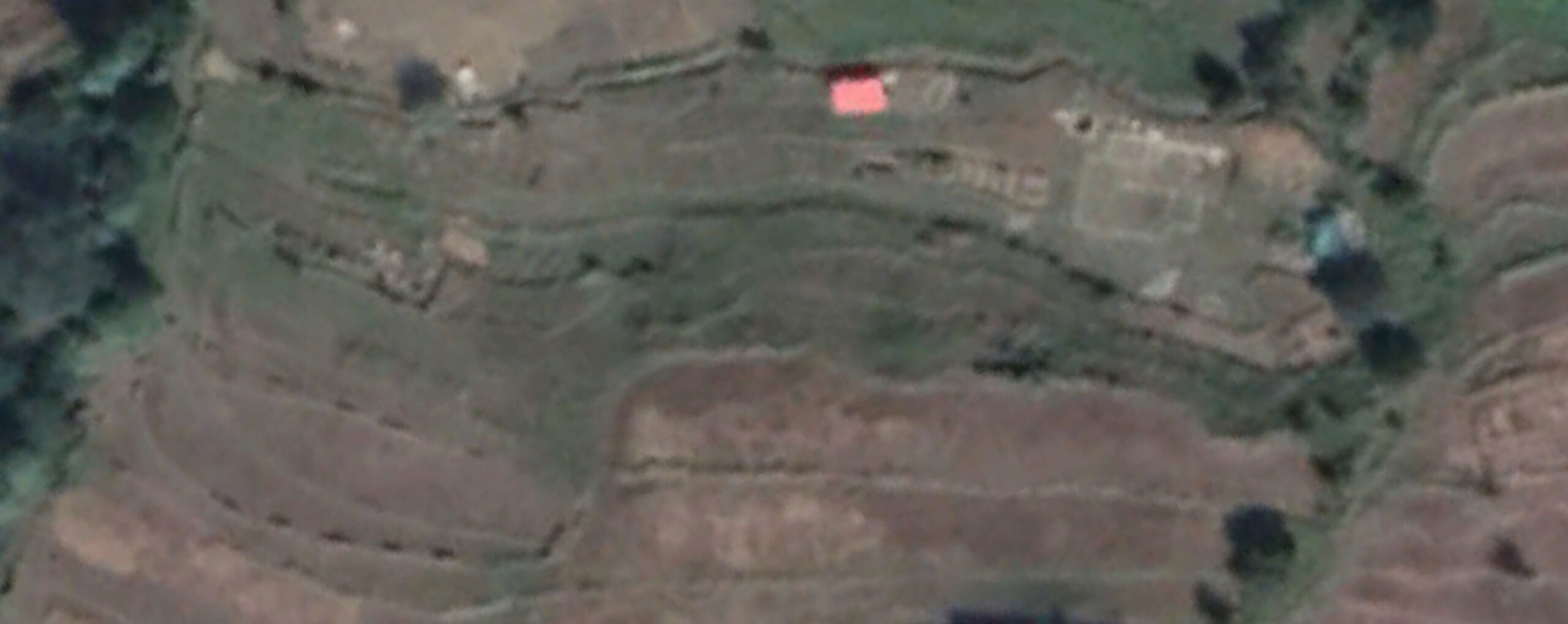
A Google map image of the land, 2019.
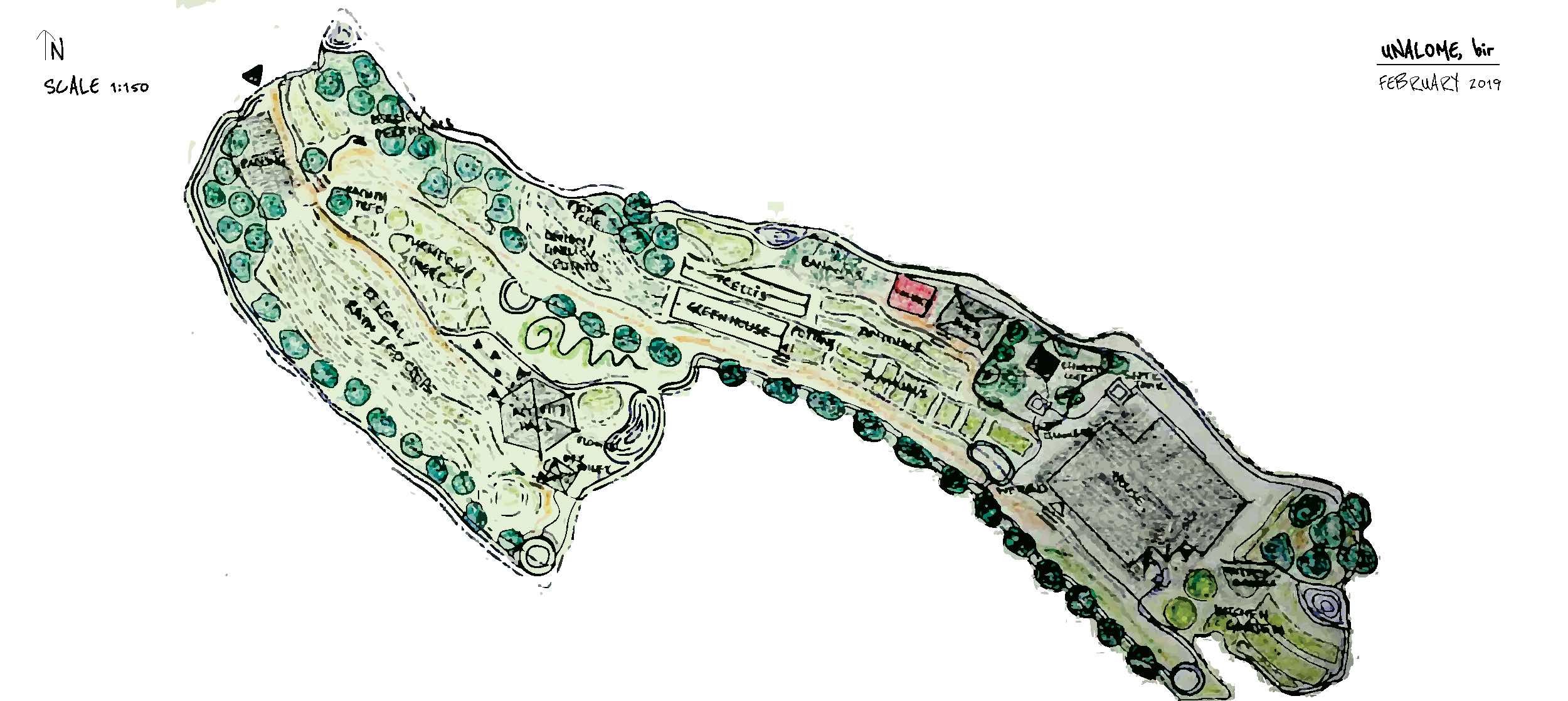
A design for the land, made in 2019.
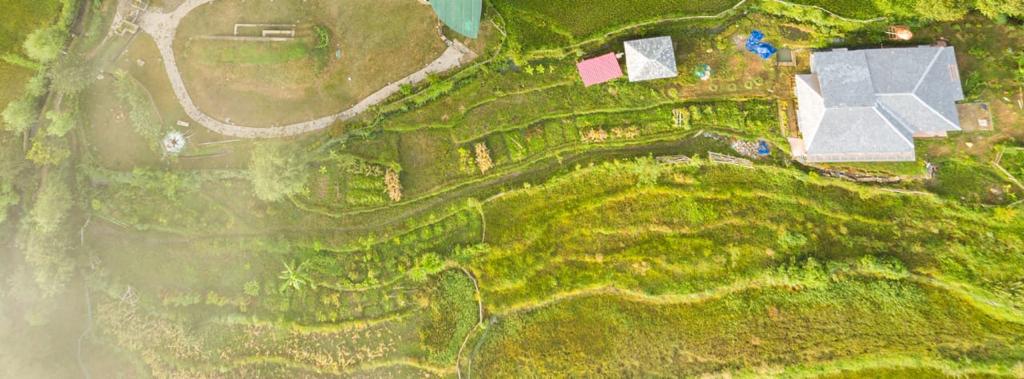
A picture of the land in October 2020.
The entire land has been imagined as a super-forest with clearings in between for shelter and farming.
Thus the elements of water, structures, and the farm are integrated with the forest spaces through pathways, channels, and biomass flows.
We made a conscious decision of minimizing the impact on the existing landscape and the structures and pathways have been designed accordingly.
Built spaces
Footprint: 600 sq. meters (20% area)
This includes pathways, house, septic tank, parking, guest house units, activity hall, space for camping, common toilet, compost shed, and toolshed. Some of these structures have been built, some have been designed and the others will be designed and built in the coming years. The general location of each has already been planned with the flexibility of change as per the final design of the structures themselves.
A note on pathways
The pathways are a very important part of land design. Pathways can make human circulation efficient and minimize human impact on the land. They also serve as water harvesting structures and water channels.
Farm
Footprint: 1440 sq. meters (48% area)
The farm or the actively cultivated part of the land comprises of a vegetable garden for annuals, a grain field for cereals, a greenhouse and permanent trellises for vines and cucurbits. This covers the majority of the land.
As more work is done in finding seeds for perennial food crops, more and more of this area can be turned into guilds of perennial plants, shrubs, and trees.
Forest
Footprint: 600 sq. meters (20% area)
The entire land has been imagined as a forest with clearings in between for shelter and farming. The wilderness and diversity that already existed have been preserved and edges and sections have been used to create a mix of native and edible trees with a diverse understory.
Earthworks
Footprint: 400 sq. meters (12% area)
These include water channels, swales, and ponds created to manage the flow of water, spread it across the land and allow infiltration and storage.
EARTH
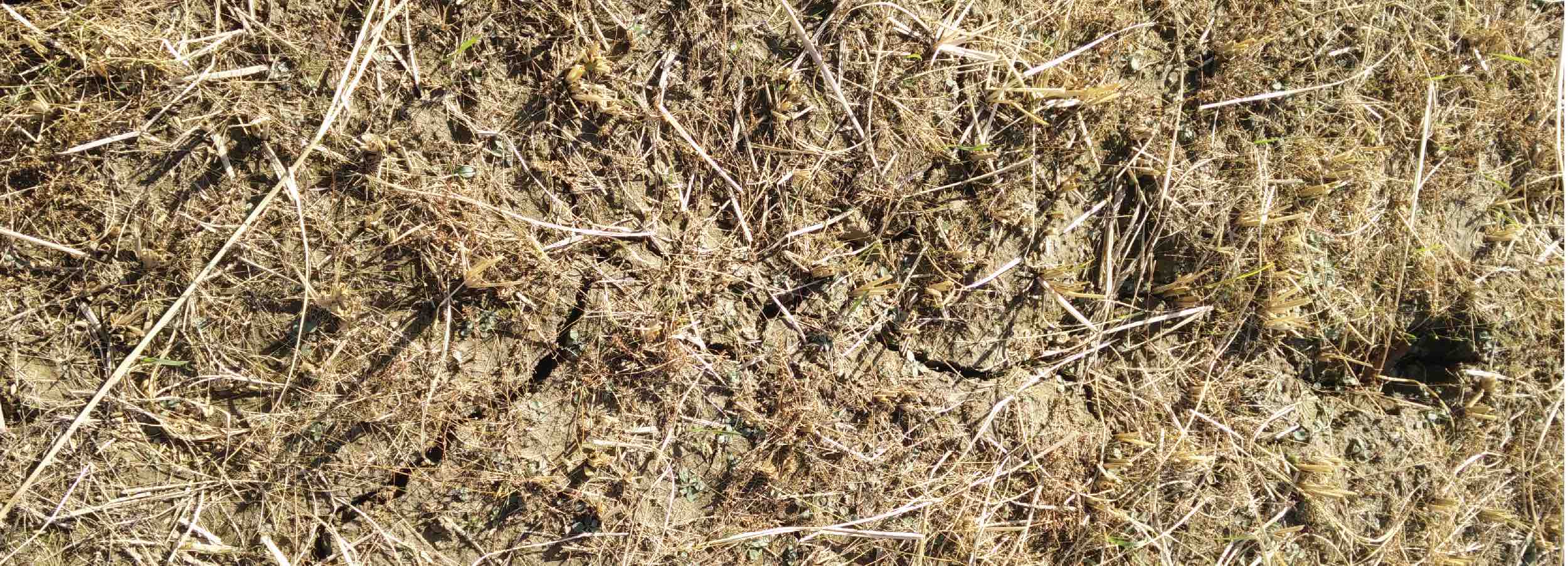
While walking on the land for the first time, the successive monocropping, tilling and use of chemicals was evident from the compaction, poor diversity of weeds, lack of moisture and life in the soil.
The soil structure seemed good and it felt that the potentiality of the soil just needed some care and sensitivity to express itself fully.
We also did a biological test using a microscope to only confirm what we had observed with our senses.
The soil lacked biological diversity with very low numbers of bacteria and hardly any fungus (because of repeated tilling). The higher predators of the soil food web were also missing (because of high usage of fertilizers and pesticides), which meant low nutrient cycling.
The first step here was to designate zones for forest and farm and work on the soil accordingly.
(Forest soil requires more carbon than nitrogen to develop healthy fungal networks which support shrubs and trees while farm soil is a balance of bacteria and fungi and requires a diversity of carbon and nitrogen biomass.)
SOIL BUILDING METHODOLOGY
Raised beds

Raised beds are helpful in the following ways:
– Clear human circulation will prevent stepping on beds and compaction
– No tilling or digging required
– Beds can be designed for ease of working and access
– Prevention of waterlogging in monsoon as pathways serve to channelize runoff water
Raised beds can be made anywhere on the site and hence contribute to increasing the overall production area. Also, a diversity of biomass can be used to make the raised bed ‘lasagna’ which helps in utilising the biomass obtained from clearing the land the first time.
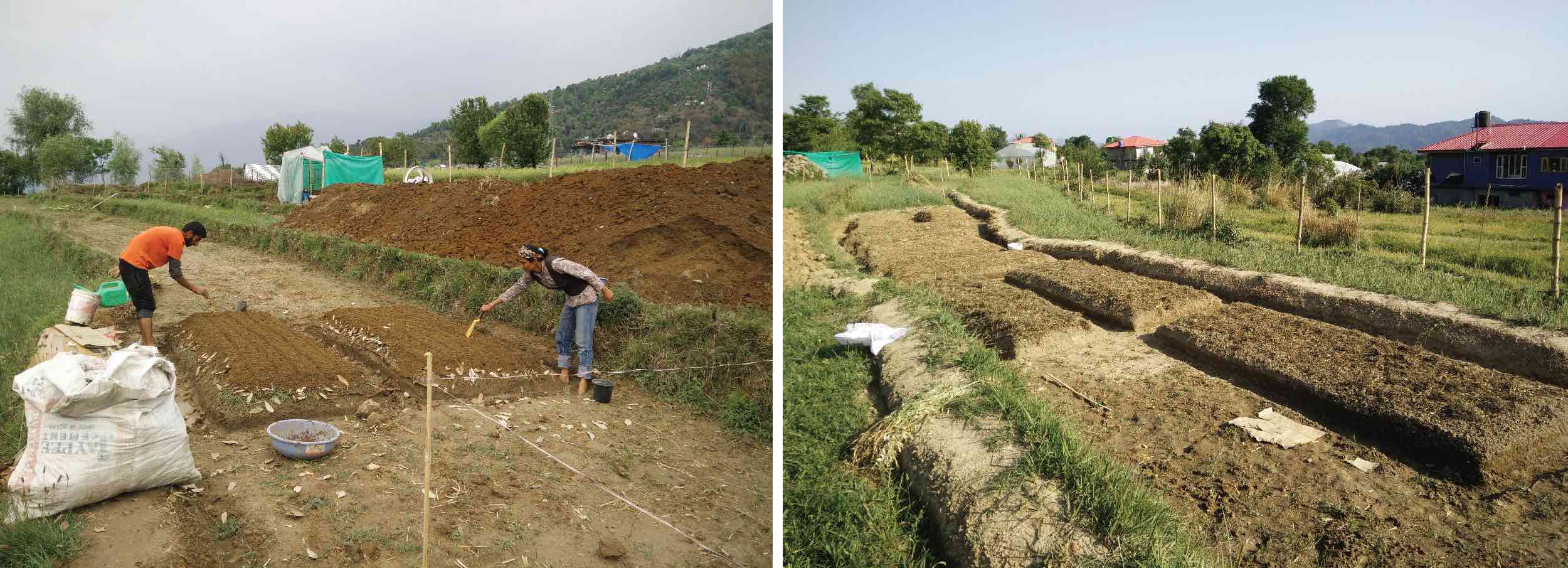
Green manure
Although different growing areas will take time to come up, none of the growing areas were left fallow at any point. Seeds of fast-growing and hardy plants were thrown in right after the first rains. These were then chopped after the first flowers appeared and dropped on the ground to facilitate rapid nutrient cycling to help accelerate natural succession. Some of the biomass gained from these beds was also used to make compost for the raised beds.

Soybean is grown to be chopped and dropped on the bed
Mulching
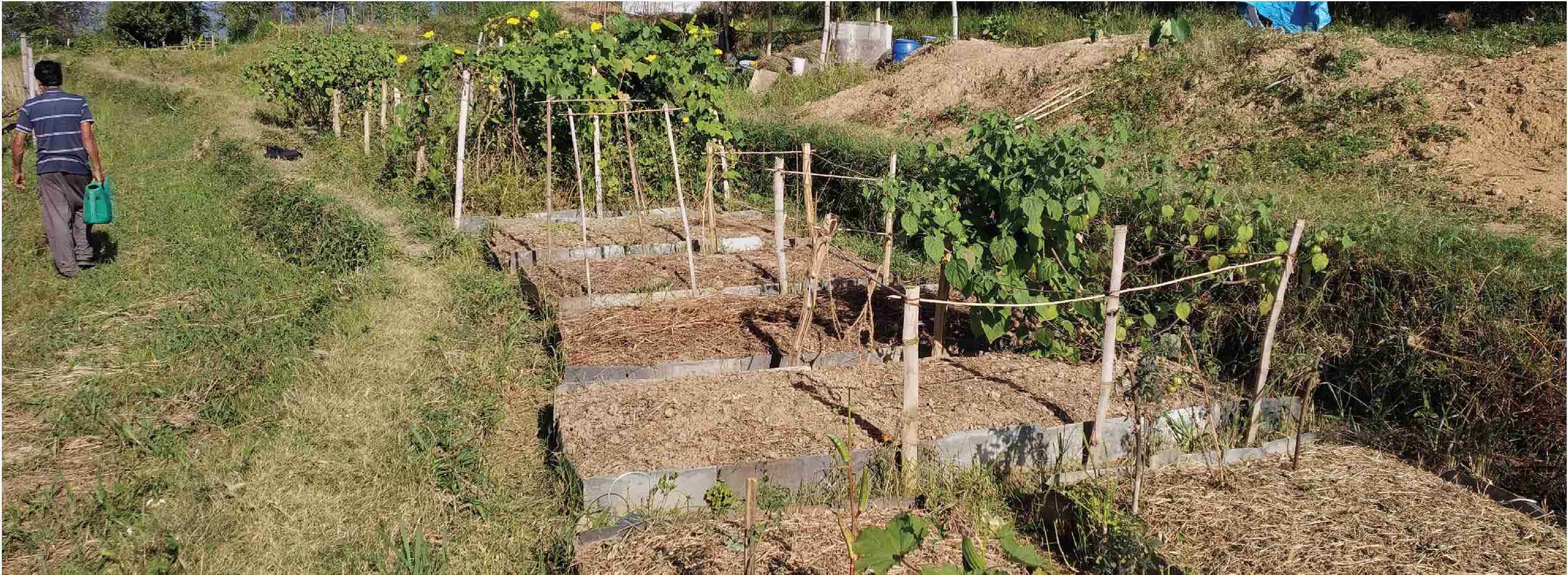
The benefits of mulching cannot be overemphasised. After mulching for a few months, we could already observe good soil moisture content, better structure, and return of critters in the soil. Mulching with material available from the land has been an important decision to promote indigenous microbes in the soil. The design takes into account the need for mulch for the farm and the edges have been used to plant fast-growing grasses, wild shrubs, and pioneer plants that can be cut and put back on the soil when needed.
Compost
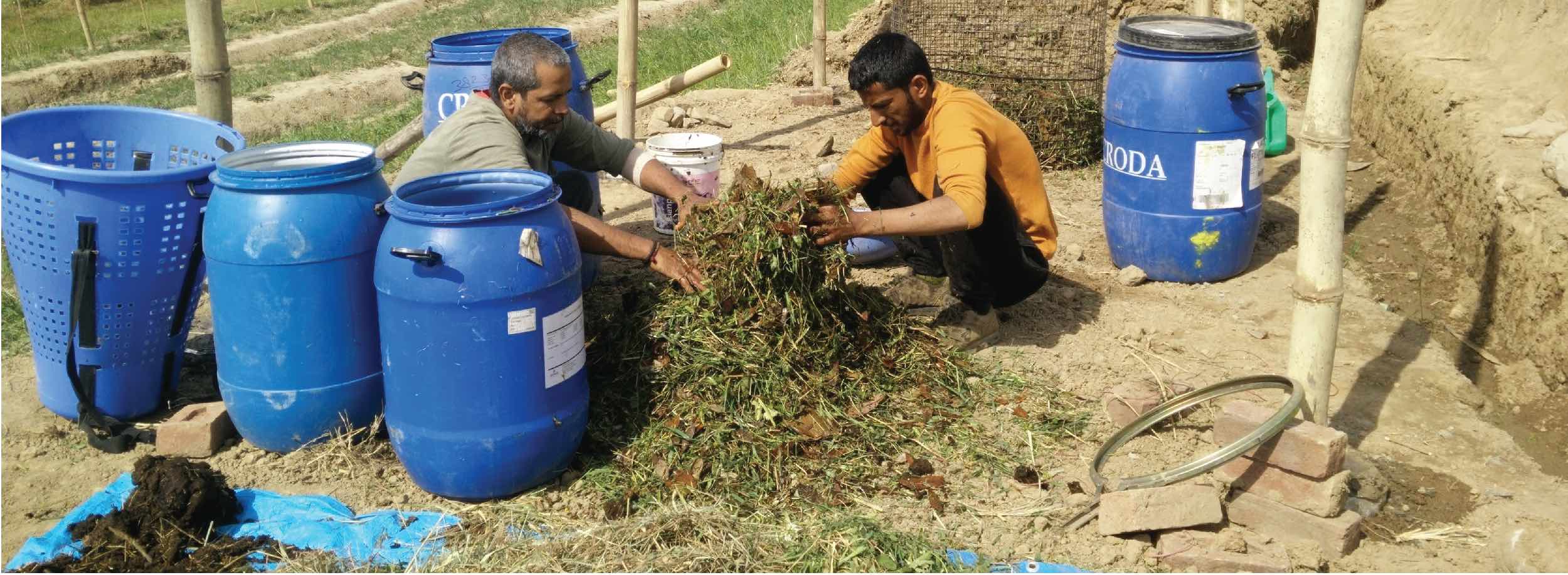
Composting is a way of accelerating the natural decomposition processes. Compost will help in accelerating the ecological succession on the land. Thermal compost was made with almost equal proportions of dry and green material to start with. With observation and improvement in the recipe for the specific context, separate compost piles for the forest (with more carbon than nitrogen) and the farm (about equal proportions of carbon and nitrogen) will be made. Eventually, as the recipe becomes better and the soil health improves the amount of compost being used will also reduce. The key here is local material and as much diversity as possible.
Water management
Managing flow of water is an essential part of soil building. Erosion and leaching have to be minimised and infiltration has to be optimised to keep the soil living throughout the year. For this, swales, water channels, and ponds were instrumental. They are described in detail later.
Successional planting
While working with soil, we are participating in the natural succession where soil biology moves from bacterial dominated system to a fungal dominated system and the natural vegetation evolves from ‘weeds’ and grasses to shrubs and trees. Observing and utilising these patterns can accelerate the healing process of the soil. This method is being used both in the forest and the farm with plant consortiums from different successional stages.
A note on greenhouse
A greenhouse hugely benefits the food growing capacity of a farm in the temperates with short growing seasons and extremely cold winters. It is not only useful to grow food in times of uncertain weather conditions but also it helps in trying out new verities of plants (that may adapt to colder climates as the global temperatures continue to rise), plant propagation and starting seeds early.
Choice of plants
Only open-pollinated varieties of seeds are being grown in the farm. These are hardy, require less water and care and adapt to the changing climate and culture of the landscape. Thus the evolution of these plants is intimately linked with the evolution of the land and the farmers.
This along with the planting patterns and combinations of diverse crops ensures food security in times of uncertain climatic conditions.

WATER
The best place to store water is in the ground.
This location receives an average annual rainfall of 2000 mm. Most of this is during the summer monsoon (July-October) with some rain during the winter monsoon (December- January).
The summers are dry and the soil loses a lot of water from evaporation due to the intense sun. Therefore mulching is required to maintain soil moisture. Also, a lot of work is being done to add carbon to the soil to improve its structure and infiltration capacity.
WATER HARVESTING METHODOLOGY
Swales
Swales all along the boundaries help channel rainwater from upstream neighbors safely across the farm. Also, the swale at the bottom of the land collects runoff and leached nutrients within the land.

Pathways as water channels spread water across the land
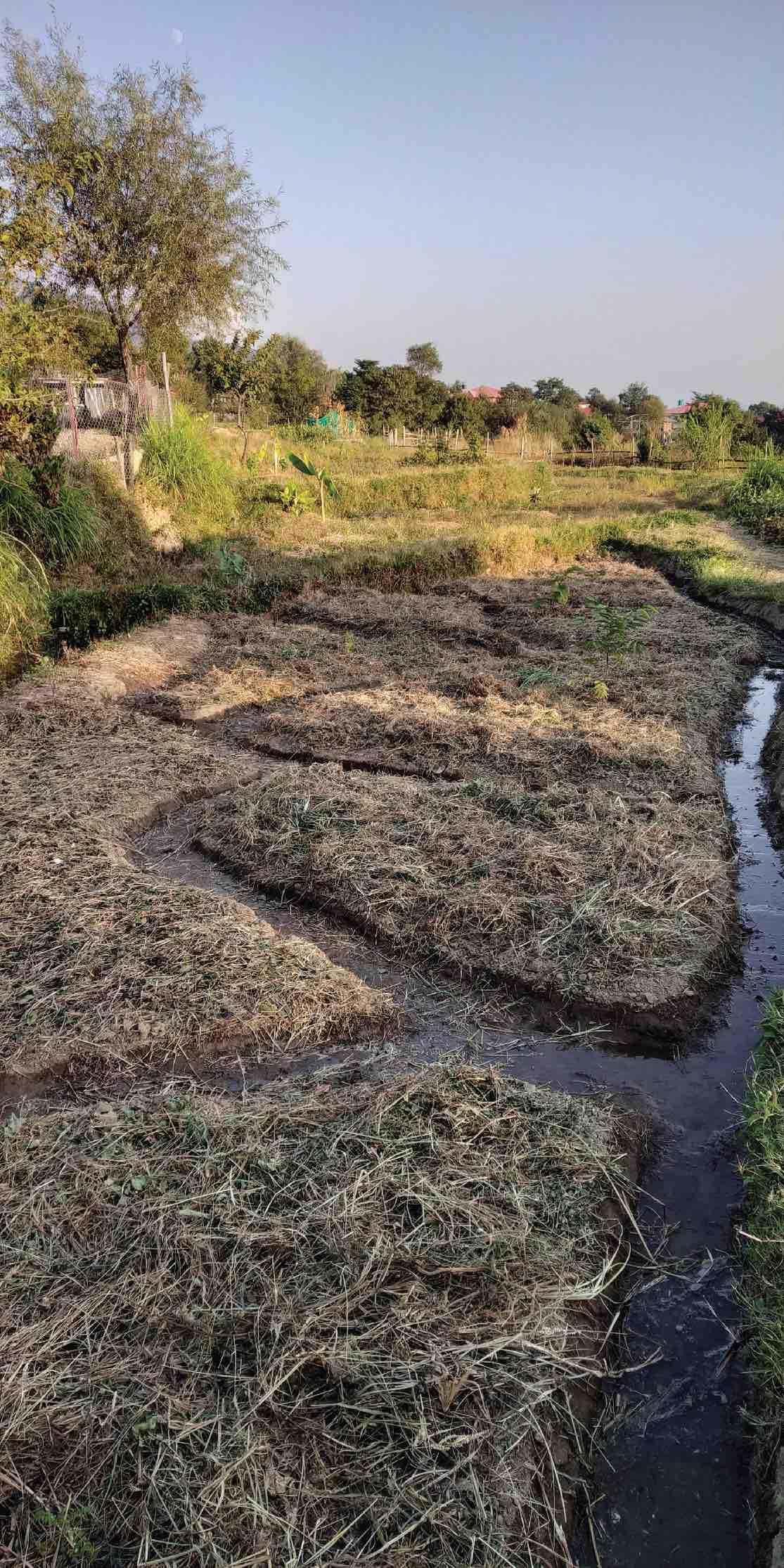
Ponds
Ponds store water for use and allow infiltration in the ground. These are connected to the swales forming a network through which water flows slowly and seeps into the deeper layers of the soil.

FIRE

Plants are like active solar panels turning heat and carbon (excess of either is not desirable) into food.
Plant cover shades the soil from the sun, thereby keeping it cool and moist. This allows the soil life to thrive, which maintains soil structure which means healthier plants, better water retention and so on.
Also, plants spend their days turning Carbon-dioxide in the air into oxygen. They are the most efficient carbon sinks nature has designed. They put this carbon in the soil through root exudates and the soil food web. This means, the more plants you grow, the more carbon is moved from the air to the soil.
Therefore, dense planting is beneficial from many many aspects but most importantly for abundance and carbon sequestration.
Therefore crops and perennials are planted in dense combinations. Annual crops have companions in space and time allowing for more growth in the same bed and season.
Likewise, perennial crops have groups that share a similar successional stage (consortiums) or complement each other in vertical stratification (guilds). These groups have been designed for optimum sun access.
AIR

The land receives strong winds from the North and Northeast directions for the majority of the year except during the monsoon season when there are strong winds also from the south.
Windbreaks
The vegetation on the northern boundary will act as a natural windbreak for the farm and structural elements. A more-dense windbreak has been incorporated in the design on the northeast corner of the land. This location receives some shade already from the existing trees and will complement the forest system design. This is also the forest garden element, which forms a part of the larger garden area around the house.
Forests
The forests are both elements for modifying the flow of air, and at the same time improve the quality of air. As mentioned earlier, the intention of Nishtha and Rohit and our design was to turn as much of the land into a forest as possible. These are the elements that have been imagined as a forest whose presence is uninterrupted on the land.
Wild
Some of the wild spaces are already designated and some will evolve around the structures and the farm. The diversity here will be of native shrubs and trees along with varieties of local and exotic fruits and berries. The forest spaces have been planted densely with fast-growing pioneer species along with their successional complements. These will be pruned, chopped in a couple of years to generate high carbon biomass and provide clearing for sun and the desired trees to grow.
Edible Perennials
There are also areas where fruit trees have been planted (some are native and some are ‘improved’ grafted varieties). These trees will exist in guilds of other perennial edibles like berries, herbs, roots, and vines.
Living Fence
A 60 cm wide growing area will run all along the fence of the land on all sides. This thick perennial wild growth will form a living fence that will not require yearly or seasonal repair and provide a habitat for birds and insects.
The fence is slowly becoming a complex and diverse polyculture and an extension of the forest systems being grown on the upper terraces, thus contributing to the overall food production on the land.
COMMUNITY
The design has taken into consideration the impact of this project on its neighbours and of its neighbours on the project- shade from structures, runoff water, noise, visual barriers for privacy, etc. The living edible fences are also one way of sharing the abundance of the land with neighbours and passers-by.
Finally, the success of this project depends on its relationships with the larger community and the ecosystem.
This continues to be a work in progress and our hope is that the design and observations from this land will help other land development projects in the area to employ sustainable soil, water, and agricultural systems in a natural way using local material, labour, and skills.
 _________________________________________________________________________
_________________________________________________________________________
All photos by Nishtha and Rohit
